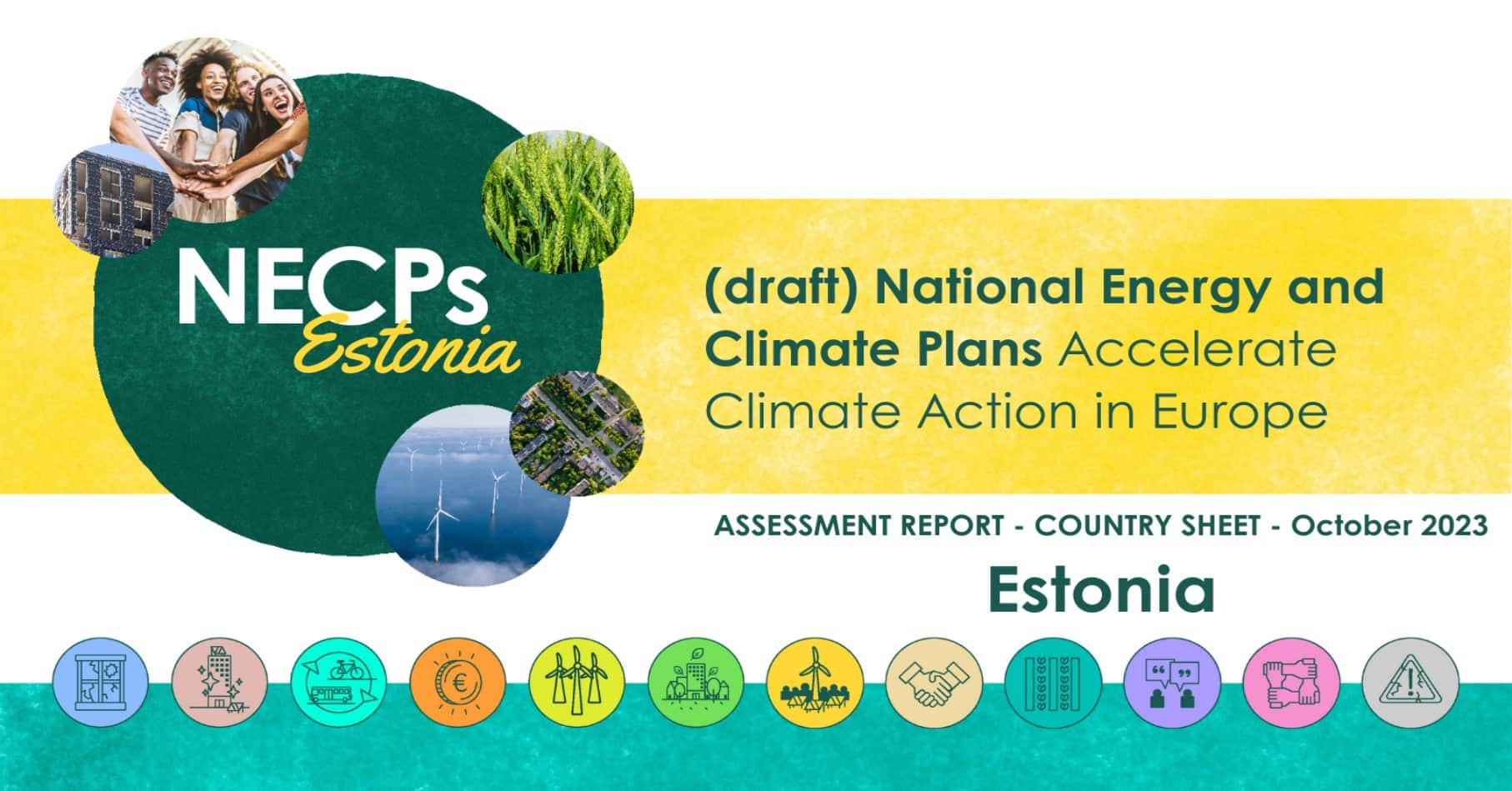Estonia has submitted its draft National Energy and Climate Plan (NECP) update on time. This assessment is based on the version submitted to the Commission. Estonia fulfils the minimum EU requirements for climate efforts sharing and renewable energy, however overall it does not move towards a 1.5°C trajectory. The energy efficiency contribution for primary energy is almost aligned with the EU 2030 energy efficiency target, while it fails to do so for final energy consumption. As the draft is mostly a summary of pre-existing national targets and measures, and it is not used as a strategic document to improve ambition, it reflects the main shortcomings of Estonia’s climate and energy policy: the lack of a clear oil shale phaseout plan and the lack of policies to reach its LULUCF target.
RECOMMENDATIONS
- Set binding deadlines for oil shale phaseout. The current TJTP targets are not binding, and the oil shale industry plans to continue mining even after 2040;
- Set clear targets for reducing logging volumes and peat extraction, in order to at least achieve the LULUCF target of 2.5 Mt of CO2 sequestration by 2030;
- Turn the NECP into a strategic plan to raise climate ambition. The NECP should be merged with the Estonian Energy Policy Development Plan (ENMAK). The climate law currently in preparation should also provide a clear framework for Estonian energy and climate policy and set more ambitious targets.
Climate Ambition
The draft simply reflects climate targets agreed as per EU requirements – notably the 2030 Effort-Sharing Regulation (ESR) target for non-Emission Trading System (non-ETS) sectors (-24% compared to 2005 levels) and the 2030 Land Use, Land-use Change and Forestry (LULUCF) target of 2.5 MtCO2-eq by 2030.
With the additional planned policies and measures (PAMs), Estonia would be able to meet its (unambitious) 2030 non-ETS target, but it would fail to achieve the 2030 LULUCF target. Since 2017, LULUCF has become an emitting sector in Estonia, and the draft predicts the same emissions rate to continue until 2050. The trend must be reversed by introducing measures that lower forestry annual cutting yields, reduce peatland farming, and support rewetting drained peatlands, for example by introducing sustainable practices such as paludiculture. Measure MM2 should be deleted, as it ensures harmful “business-as-usual” forest farming to continue.
Energy Transition
Estonia sets a renewable energy contribution of 65% by 2030 which will surpass the Governance Regulation formula benchmark to reach the binding EU 2030 renewable energy share of 42.5%. While some good measures are planned, the draft notably misses additional measures promoting energy communities.
For energy efficiency, the level of energy consumption foreseen for 2030 is 45.72 TWh for primary energy and up to 30.19 TWh for final energy, which equals 3.93 Mtoe and 2.59 Mtoe respectively. This is close to being in line with the required national contribution to meet the EU 2030 energy efficiency target for primary energy and leaves a small gap of 0.04 Mtoe for final energy compared to the formula benchmark of the 2023 Energy Efficiency Directive (EED). Estonia complies with the formula deviation flexibility for final energy consumption. However, Estonia does not plan any new measures compared to its 2019 NECP. The Estonian Energy Policy Development Plan (ENMAK) is currently in the final stages of preparation and will give further guidance to the final NECP.
FOSSIL FUELS ALERT
- Oil shale – Oil shale is still presented as crucial for Estonia’s decarbonisation efforts. The forecast of primary energy production shows oil shale use unchanged by 2030, and only decreasing around one third in 2050. This contradicts the projections with additional measures for energy sector emissions, which foresees a drop from 3Mt in 2040 to 0.2 Mt in 2045, as a result of oil shale phase out after 2040.
IS MONEY WHERE THE MOUTH IS?
- Funding is robust – but is uncertain beyond 2027, due to the Estonian state budget strategy spanning four years.
- The EU funds’s impact is limited by the weak nature of some of the measures they finance.
SNEAKY SUBSIDIES
- Estonia claims that fossil fuel subsidies accounted for 22% of the energy subsidies paid in 2021. Unfortunately, the real number is much larger. Many subsidies mentioned by the State Audit Office report are omitted, including 661 million euros of free allowances for the oil shale industry between 2013 and 2021.
PUBLIC PARTICIPATION
- Stakeholder involvement was not early and effective, as the most substantive aspects of the plan were already decided before the public could influence the process. Projections with additional measures were not discussed. Proper consultations are required before the final deadline.
- The Energy Council of the Ministry of Economic Affairs and Communications cannot be considered as a multilevel dialogue – as it is presented in the draft – because it does not involve the general public.
Download estonia country sheet NECP assessment report
Download FULL NECP assessment report
PREVIOUS
NEXT

